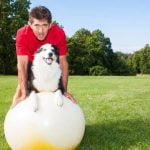Is your furry friend wreaking havoc on your shoes, furniture, and other household items? If so, you may be in need of some guidance on how to train a dog to chew only toys.
Understanding the importance of training your dog to chew toys is essential for both their well-being and the harmony of your home. In this article, we will explore the natural instincts of dogs to chew, how to select the right toys for your pup, and effective techniques for introducing and encouraging toy chewing behavior.
Dogs have a natural inclination to chew as a way to relieve stress, exercise their jaws, and keep their teeth clean and healthy. However, if not directed properly, this instinct can result in damaged furniture and frustration for pet owners. By training your dog to chew only toys, you can redirect their natural chewing tendencies towards appropriate outlets while preventing destructive behaviors in the home.
The first step in this training process is understanding the natural instincts of dogs to chew. Once you have a grasp of why dogs chew and what types of toys are most appealing to them, you can then begin selecting the right toys for your furry companion. With patience, consistency, and positive reinforcement techniques, you can effectively train your dog to channel their chewing habits towards designated toys instead of household items.
Understanding the Natural Instincts of Dogs to Chew
Dogs have a natural instinct to chew, and it is important for pet owners to understand this behavior in order to successfully train their dogs to chew only on toys. Chewing is a normal and necessary behavior for dogs, as it helps to relieve stress, keep their teeth clean, and provides mental stimulation. However, if not directed appropriately, chewing can result in destructive behavior such as gnawing on furniture, shoes, or other household items.
To effectively train a dog to chew only toys, pet owners must provide their dogs with appropriate chew toys that are safe and durable. It is important to consider the size and breed of the dog when selecting toys to ensure they are suitable for their chewing needs. Interactive toys such as puzzle feeders or treat-dispensing toys can also engage a dog’s mind and keep them entertained for extended periods of time.
When introducing a new toy to a dog, it is crucial to encourage positive associations with the toy through playtime and praise. Pet owners can use treats or verbal cues to guide their dogs towards the designated chew toys. Establishing a routine for chewing sessions can help reinforce the behavior and minimize inappropriate chewing on non-toy items.
In addition to positive reinforcement techniques, it is essential for pet owners to redirect any inappropriate chewing behavior immediately by calmly removing the object from the dog’s mouth and replacing it with an appropriate toy. Consistency and patience are key in training a dog to chew only on toys, as this behavior may take time for some dogs to learn and adhere to consistently.
Selecting the Right Toys for Your Dog
When it comes to training your dog to chew only toys, selecting the right toys for your furry friend is crucial. Not all toys are created equal, and it’s important to choose ones that are safe, durable, and appealing to your dog’s chewing instincts. Here’s how to go about selecting the right toys for your dog.
First and foremost, consider the size and breed of your dog when choosing toys. Smaller dogs may prefer softer toys that they can easily carry around, while larger breeds may require more durable options that can withstand their powerful jaws. It’s also important to consider the age of your dog – puppies may benefit from teething toys, while older dogs may enjoy interactive puzzles or treat-dispensing toys.
Additionally, take into account your dog’s chewing style. Some dogs are aggressive chewers and may need tougher rubber or nylon toys, while others may prefer plush or rope toys for gentler play. Keep in mind any specific preferences your dog has shown in the past, such as a preference for squeaky toys or a particular material.
Finally, always prioritize safety when selecting toys for your dog. Avoid toys with small parts that could be swallowed or sharp edges that could cause injury. Look for reputable brands and carefully inspect toys for any signs of wear and tear before giving them to your dog. By considering these factors and choosing the right toys for your dog, you can set them up for success in learning to chew only their designated playthings.
In addition to choosing the right types of materials and sizes that suit what a particular pet might like best based on their breeds’ habits (which can change dramatically), careful testing should help ensure this will not be a concern moving forward. Be sure these measurements allow enough room inside our mouth but not too much excess space-a snug fit at all times.
Although many off-the-shelf supplies satisfy most demands under normal conditions we want so long maintenance costs. Remember if possible avoid buying anything untested because who knows?
Introducing and Encouraging Toy Chewing Behavior
When it comes to training your dog to chew only toys, it’s essential to understand that dogs have a natural instinct to chew. It is important to introduce and encourage toy chewing behavior early on in your dog’s life. This not only helps prevent destructive chewing of household items, but also promotes good dental health and mental stimulation for your furry friend.
Here are some tips on how to train a dog to chew only toys:
- Start by selecting a variety of safe and durable toys for your dog. Toys should be appropriate for the size and chewing strength of your dog breed.
- Introduce the toys to your dog by making them seem appealing. You can do this by playing with the toys yourself or adding a treat inside the toy to attract their attention.
- Encourage toy chewing behavior by praising and rewarding your dog when they chew on the toys. Positive reinforcement techniques such as giving treats or verbal praise can help reinforce this behavior.
It is important to remember that consistency is key when training your dog to chew only toys. Be patient and persistent in redirecting inappropriate chewing behavior and always provide an alternative, such as a toy, when you notice them attempting to chew on something they shouldn’t be. With time and dedication, you can successfully train your dog to chew only toys and avoid destructive chewing habits around the house.
Positive Reinforcement Techniques for Toy Chewing
One of the most effective methods for training a dog to chew only toys is through positive reinforcement. This involves rewarding your dog with treats, praise, or affection whenever they chew on their toys instead of inappropriate items. Positive reinforcement helps to encourage and reinforce the desired behavior, making it more likely that your dog will continue to chew on their toys.
To begin using positive reinforcement, start by keeping a close eye on your dog and as soon as you see them chewing on one of their toys, immediately praise them and give them a treat. You can also use a clicker to create a distinct sound that signals to your dog that they are doing the right thing.
Over time, your dog will learn that chewing on their toys results in positive outcomes, and they will be more likely to engage in this behavior.
It’s important to note that consistency is key when using positive reinforcement techniques. Make sure to reward your dog every time you see them chewing on their toys, especially during the early stages of training. This will help solidify the association between toy chewing and positive rewards in your dog’s mind.
| Positive Reinforcement Steps | Description |
|---|---|
| Observe Toy Chewing | Keep an eye on your dog and look for moments when they are chewing on their toys |
| Praise and Reward | Immediately praise your dog and offer a treat or affection when they choose to chew on their toys |
| Consistency | Be consistent in rewarding toy chewing behavior to reinforce the desired action |
By following these steps and consistently using positive reinforcement techniques with your dog, you can effectively train them to chew only toys while preventing inappropriate chewing behaviors.
Redirecting Inappropriate Chewing Behavior
Identifying Inappropriate Chewing Behavior
It is important to recognize what constitutes inappropriate chewing behavior in your dog. This can include chewing on furniture, shoes, or other household items, as well as showing aggression when attempting to take away the object being chewed. Understanding the difference between appropriate and inappropriate chewing will help you effectively redirect your dog’s behavior.
Using Positive Reinforcement for Redirection
When you catch your dog engaging in inappropriate chewing behavior, it is crucial to redirect their attention to an appropriate chew toy. Offer the toy to the dog and encourage them to interact with it by using positive reinforcements such as verbal praise, treats, and affection. This will help your dog associate good behavior with the act of chewing on toys.
Consistency and Persistence
Consistency is key when it comes to redirecting inappropriate chewing behavior. It may take some time for your dog to fully understand that they should only chew on toys. Continue to monitor their behavior and intervene whenever they engage in inappropriate chewing. With patience and persistence, your dog will eventually learn that toys are the only acceptable items for them to chew on.
By understanding how to train a dog to chew only toys and implementing these redirection techniques, you can effectively guide your dog towards more appropriate chewing habits while minimizing damage to your belongings. Remember that every dog learns at their own pace, so be patient and consistent in your training efforts.
Consistency and Patience in Training Your Dog
Training your dog to chew only toys requires consistency and patience. It is important to remember that dogs, like humans, do not learn new behaviors overnight. Consistency in your training methods and patience in allowing your dog to adapt to these new habits are crucial in successfully teaching your dog to chew only toys.
Consistency involves setting clear rules and boundaries for your dog when it comes to chewing. This means providing appropriate toys for your dog to chew on and consistently redirecting them when they attempt to chew on something inappropriate. Additionally, being consistent with the use of positive reinforcement techniques will help reinforce the desired behavior of chewing on toys.
Patience is equally important when training your dog. Understand that it may take some time for your dog to fully grasp the concept of chewing only on toys. Some dogs may learn faster than others, so it’s important to be patient and not get frustrated if progress seems slow. Remember that every small step towards successful toy chewing should be acknowledged and rewarded.
It’s also important to note that consistency and patience go hand in hand. Consistently enforcing the rules while being patient with your dog’s learning process will ultimately lead to success in training them to chew only toys.
| Consistency | Patience |
|---|---|
| Involves setting clear rules and boundaries | Understanding that it may take time for the dog to learn |
| Consistent use of positive reinforcement techniques | Being patient with the learning process |
Common Mistakes to Avoid in Training Your Dog to Chew Toys
Introducing Inappropriate Items as Toys
One common mistake to avoid when training your dog to chew only toys is introducing inappropriate items as toys. This could include old shoes, socks, or household items that resemble toys. When a dog begins to chew on these items, it can be confusing for them to understand which items are acceptable for chewing and which are not. It’s important to consistently offer appropriate toys and discourage the use of non-toy items for chewing.
Inconsistency in Correcting Chewing Behavior
Another mistake to avoid is being inconsistent in correcting chewing behavior. If one day you allow your dog to chew on an old sock and then scold them for doing the same thing the next day, it can create confusion for your pet. Consistency is key when training a dog, so it’s important to establish clear boundaries and consistently enforce them.
Using Punishment-Based Training Methods
Using punishment-based training methods is also a common mistake when teaching a dog to chew only toys. It’s essential to remember that positive reinforcement is much more effective than punishment. Scolding or punishing your dog for chewing on inappropriate items may create fear or anxiety, leading to other behavioral issues. Instead, focus on rewarding your pet for choosing to chew on their toys and redirecting their behavior when needed.
Training a dog to chew only toys requires patience, consistency, and positive reinforcement. By avoiding these common mistakes, you can effectively teach your furry friend which items are suitable for chewing and foster good behavior in the long run.
Seeking Professional Help for Persistent Chewing Issues
In conclusion, training your dog to chew only toys is an important aspect of responsible pet ownership. Understanding the natural instincts of dogs to chew and providing them with the right toys can help prevent destructive chewing behavior. Introducing and encouraging toy chewing, along with using positive reinforcement techniques, can be effective in training your dog to chew only on their toys.
Consistency and patience are key when it comes to training your dog. It is important to redirect inappropriate chewing behavior immediately and avoid common mistakes such as punishment or using old shoes as chew toys. Seeking professional help for persistent chewing issues may be necessary if your dog continues to display destructive chewing behavior despite your efforts.
Remember, the goal is not to suppress your dog’s natural instinct to chew but rather channel it into appropriate behavior. By following the tips outlined in this article on how to train a dog to chew only toys, you can create a safe and enjoyable environment for both you and your furry friend.
Frequently Asked Questions
How Do You Train a Dog to Chew on Toys?
Training a dog to chew on toys involves positive reinforcement and consistency. Introduce the toy to the dog, encourage them to interact with it, and praise or reward them when they do. Redirect their attention to the toy whenever they start chewing on something else.
Why Does My Dog Chew on Everything but His Toys?
Dogs may chew on things other than their toys due to boredom, anxiety, or lack of proper training. It’s important to provide a variety of toys that are engaging and safe for your dog to chew on. Understanding the underlying reason for their behavior will also help in addressing the issue.
How Do I Get My Dog to Stop Eating Her Toys?
If your dog is consistently eating their toys, it’s crucial to intervene before it becomes a health hazard. Monitor your dog while they play with their toys and remove any toy pieces that are starting to break off or become small enough to swallow.
Offer appropriate chew toys that are durable and not easily destructible by your dog’s teeth. Consulting with a veterinarian can also provide guidance on how to prevent this behavior from continuing.

Welcome to the blog! I am a professional dog trainer and have been working with dogs for many years. In this blog, I will be discussing various topics related to dog training, including tips, tricks, and advice. I hope you find this information helpful and informative. Thanks for reading!





